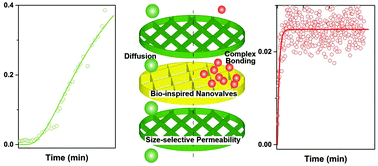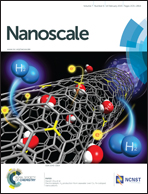Bioinspired nanovalves with selective permeability and pH sensitivity†
Abstract
Biological systems with controlled permeability and release functionality, which are among the successful examples of living beings to survive in evolution, have attracted intensive investigation and have been mimicked due to their broad spectrum of applications. We present in this work, for the first time, an example of nuclear pore complexes (NPCs)-inspired controlled release system that exhibits on-demand release of angstrom-sized molecules. We do so in a cost-effective way by stabilizing porous cobalt basic carbonates as nanovalves and realizing pH-sensitive release of entrapped subnano cargo. The proof-of-concept work also consists of the establishment of two mathematical models to explain the selective permeability of the nanovalves. Finally, gram-sized (or larger) quantities of the bio-inspired controlled release system can be synthesized through a scaling-up strategy, which opens up opportunities for controlled release of functional molecules in wider practical applications.


 Please wait while we load your content...
Please wait while we load your content...